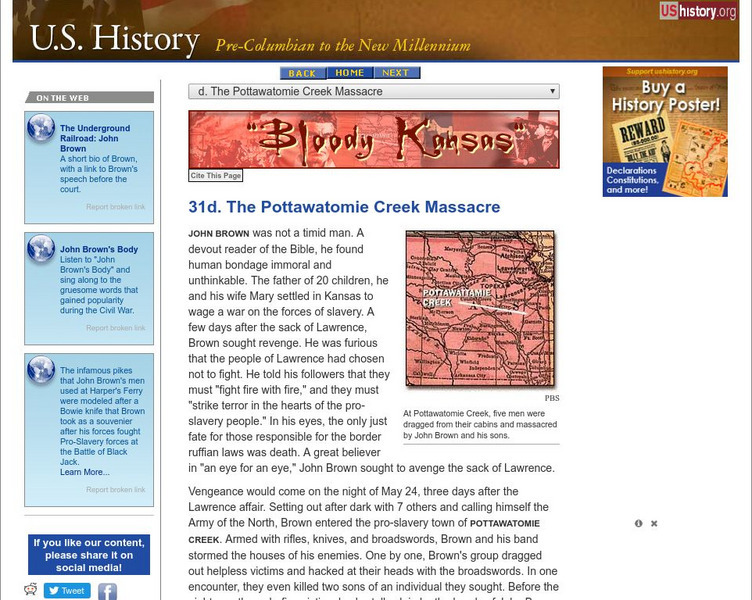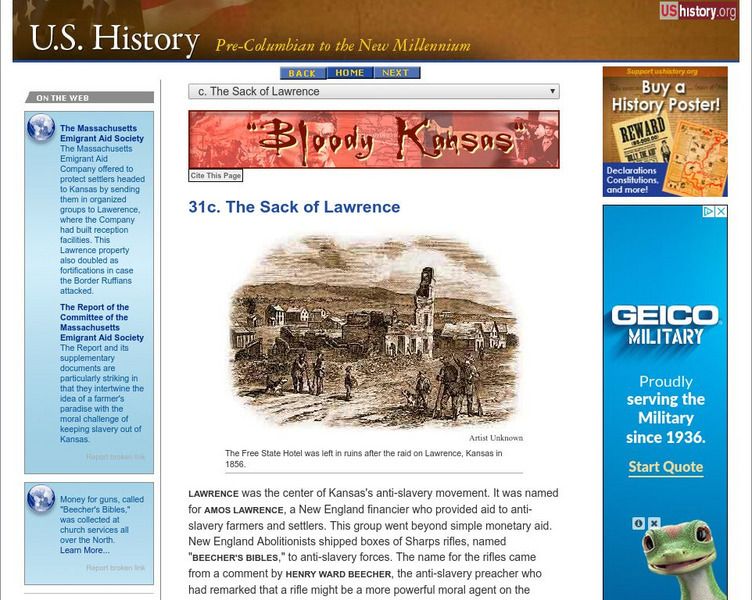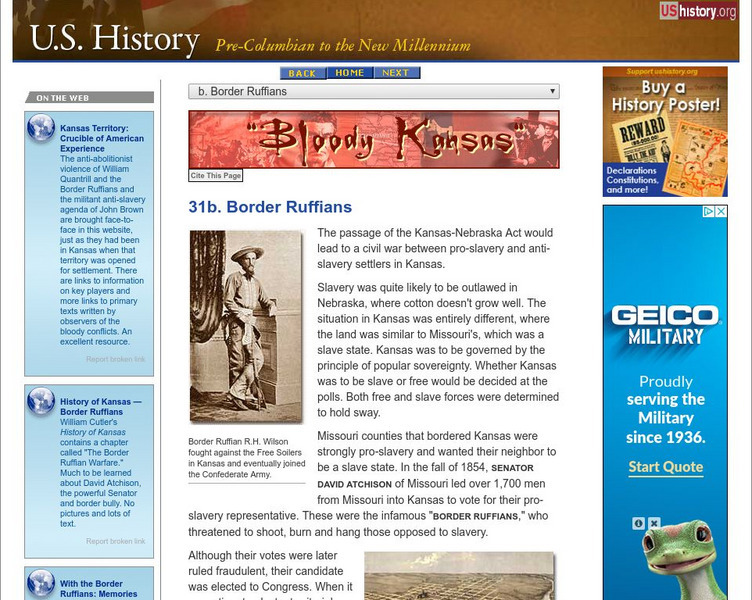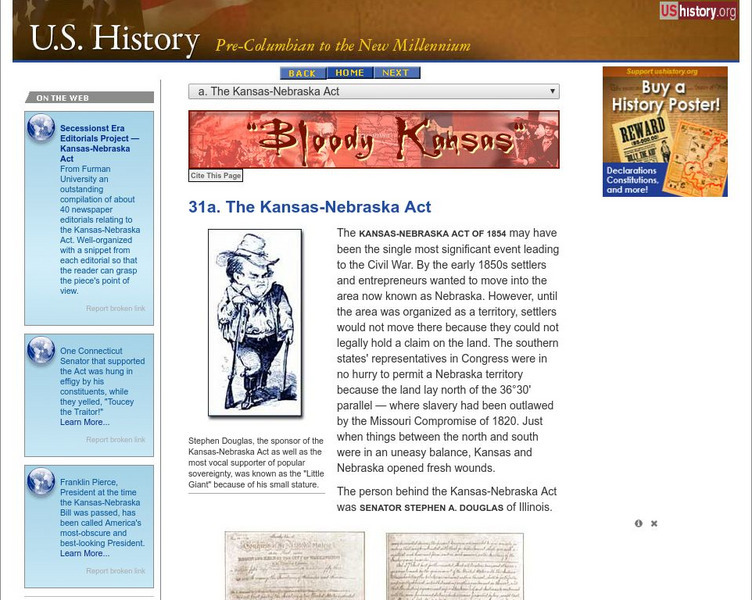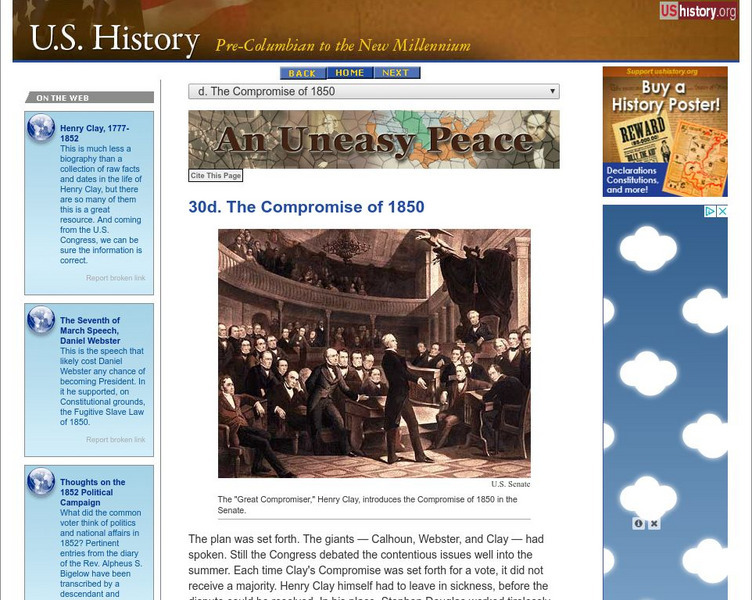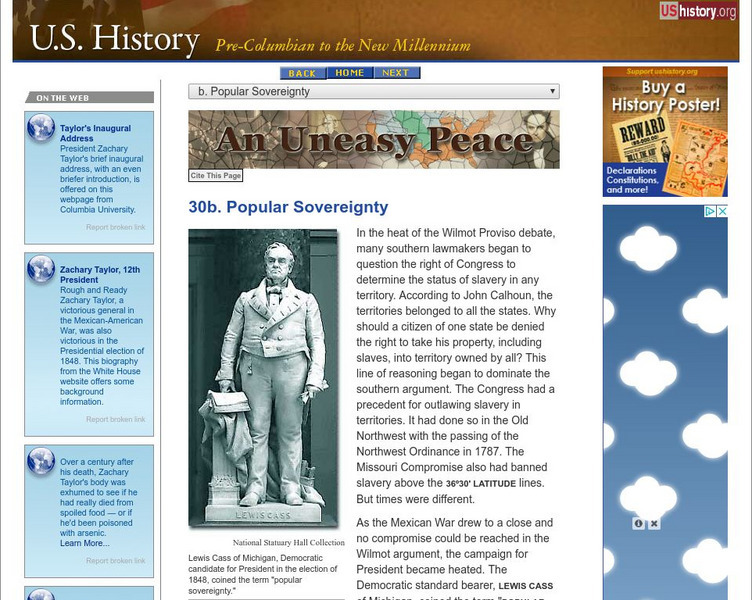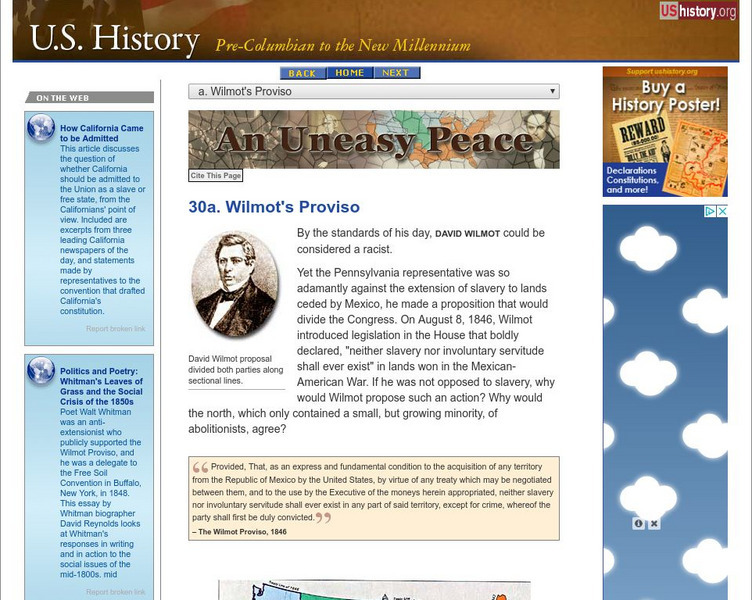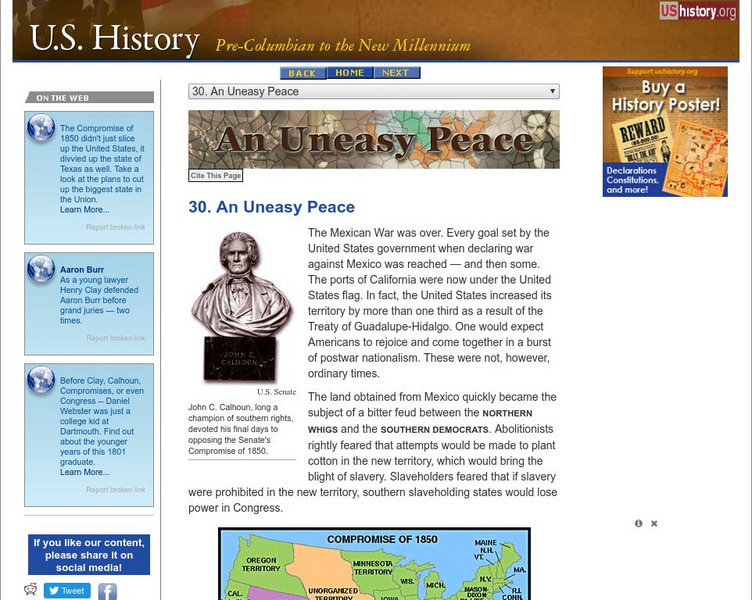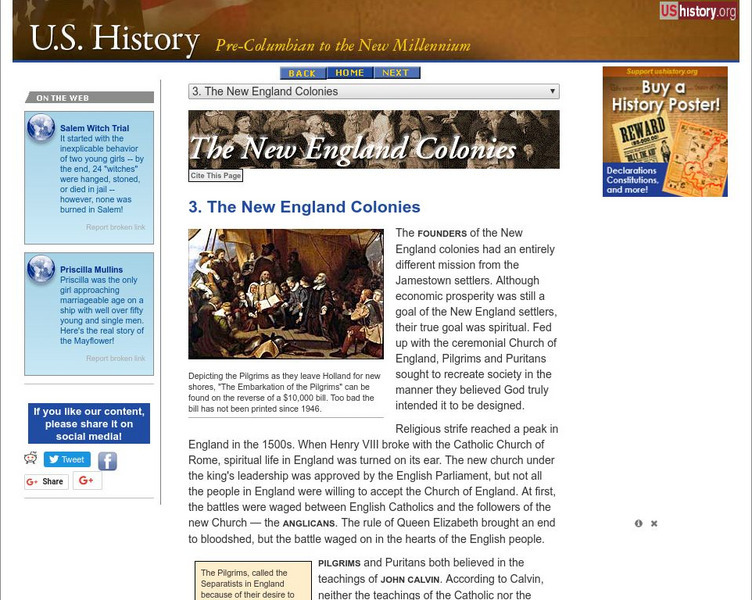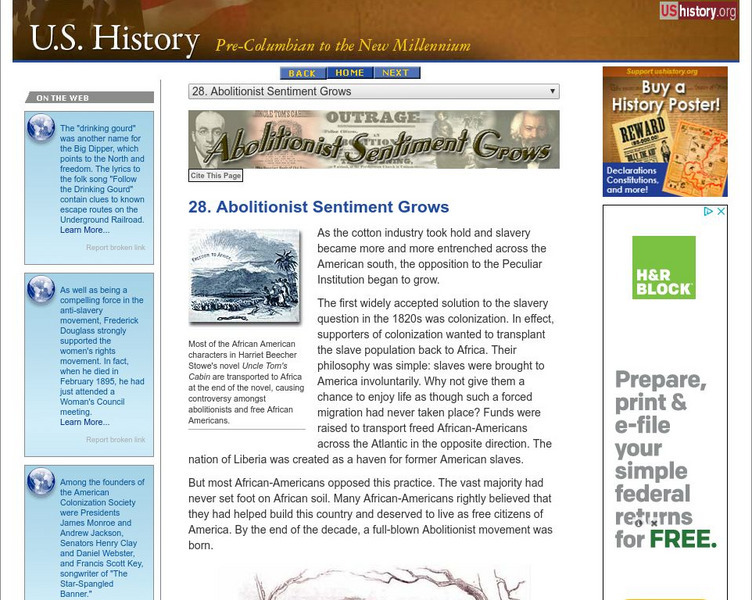Independence Hall Association
U.s. History: Canefight! Preston Brooks and Charles Sumner
Violence associated with strong feelings about slavery entered the halls of the Senate. Read what happened to Senator Charles Sumner after a two-day tirade he gave in the Senate after the sack of Lawrence, Kansas.
Independence Hall Association
U.s. History: The Pottawatomie Creek Massacre
John Brown, seeking revenge for the sack of Lawrence, Kansas, made Kansas even more bloody. Read about the Pottawatomie Massacre and its reverberations throughout Kansas.
Independence Hall Association
U.s. History: The Sack of Lawrence
Read about how the destruction of Lawrence, Kansas, seat of the Free-Soiler government by border ruffians inflamed attitudes in the North toward the actions of the slave-holders.
Independence Hall Association
U.s. History: Border Ruffians
Because of the terms of the Kansas-Nebraska Act, a election would be held to determine whether Kansas would be a slave or free state. Read about the fraudulent votes cast by the so-called border ruffians from Missouri, and see how Kansas...
Independence Hall Association
U.s. History: The Kansas Nebraska Act
Read about the essential repeal of the Missouri Compromise, which had established which states could be slave and which would be free for thirty years, with the rancorous passage of the Kansas-Nebraska Act. See who supported it and why,...
Independence Hall Association
U.s. History: "Bloody Kansas"
Here's an overview of the turmoil caused in the Kansas-Nebraska territory as a result of the Kansas-Nebraska Act. Read about the potential of conflict between the free-soilers and the border ruffians.
Independence Hall Association
U.s. History: The Compromise of 1850
Find the various parts of the Compromise of 1850, proposed by Henry Clay, that extended slavery in some cases, prohibited in others, and added California as a free state. A clear chart shows what parts of the law were beneficial to the...
Independence Hall Association
U.s. History: Popular Sovereignty
Read about the concept of popular sovereignty in relation to issue of expansion of slavery in the territories. It was not as simple as it seemed. Find out about how the issue of slavery was addressed in the election of 1848. Included is...
Independence Hall Association
U.s. History: Wilmot's Proviso
Congressman David Wilmot, even before the end of the Mexican-War, proposed legislation that would outlaw the expansion of slavery into the new territory, should the United States acquire it. Read about his reasons for proposing the...
Independence Hall Association
U.s. History: An Uneasy Peace
See what turmoil resulted from the acquisition of new territory after the Mexican-American War. There was great disagreement between those who wanted to abolish slavery and those who wanted to be able to carry slavery into the new lands....
Independence Hall Association
U.s. History: The New England Colonies
New England colonies and society were very different from the Jamestown and subsequent Southern colonies. Find out the reasons the colonists had for founding the New England colonies.
Independence Hall Association
U.s. History: Britain in the New World: War and Peace With Powhatan's People
Read about how Powhatan and his tribe initially helped the English settlers in Jamestown, but ultimately went to war. Find out about why the different views about land ownership exacerbated the tension between the two cultures.
Independence Hall Association
U.s. History: Britain in the New World: Jamestown Settlement
Jamestown, although not a financial sucess, was the first succesful English colony in North America. Find out how the colony was financed, what the first colonists hoped to find, how the colony was governed, and the hardships that were...
Independence Hall Association
U.s. History: Britain in the New World: Joint Stock Companies
A very good explanation of how early English settlements were financed, and why the English government refused to invest in such ventures. See who led such companies, who were willing to go to the New World, and why English colonies were...
Independence Hall Association
U.s. History: Gold in California
The gold rush in California accelerated the western migration of thousands of young American men, who streamed into California to find riches. See who else arrived in California and find out what they did. In addition, there is a map...
Independence Hall Association
U.s. History: The Lone Star Republic
Why did Mexico encourage settlement of Americans in Texas? Why did the Americans chafe under Mexican rule? Find out how this led to the Texas Revolution and the declaration of Texas as an independent country.
Independence Hall Association
U.s. History: Harriet Beecher Stowe Uncle Tom's Cabin
Harriet Beecher Stowe threw gas on the fire of the slavery issue with the publication of her novel, Uncle Tom's Cabin. Read about her background as an abolitionist, and find out the influence her book had in the North and even in Great...
Independence Hall Association
U.s. History: The Underground Railroad
A brief look at the Underground Railroad and how it operated. Find some of the code words used to help runaway slaves find their way, and read about some of the "conductors" who led slaves along the routes to the North.
Independence Hall Association
U.s. History: African American Abolitionists
Read about three African-American abolitionists who worked alone and in concert with white abolitionists. The most radical was David Walker, who was the founder of radical abolitionism.
Independence Hall Association
U.s. History: William Lloyd Garrison and the Liberator
Read a good biography of William Lloyd Garrison, who was one of the new, radical abolitionists who thought slavery was absolutely immoral and should be ended immediately. He was the publisher of the abolitionist newspaper, The Liberator....
Independence Hall Association
U.s. History: Abolitionist Sentiment Grows
Abolitionists had been active since the end of the Revolutionary War, but in the 1830s they became more radical in their demands to end slavery. See what their solutions were, and read about how abolitionist views were thwarted in the...
Independence Hall Association
U.s. History: The Southern Argument for Slavery
In order to convince oneself that owning another was defensible, Southerners aruged that there were economic, religious, historical, and legal reaons that slavery was a good thing. Read about some of these justifications in more detail,...
Independence Hall Association
U.s. History: Rebellions on and Off the Plantation
Slaves resisted their bondage in many ways. Read about the revolts planned and executed by Denmark Vesey and Nat Turner, the southern reactions to those revolts, and the ways slaves individually resisted their enslavement.
Independence Hall Association
U.s. History: Free (?) African Americans
Not all African-Americans were slaves in the South. Some were freed by their owners, others escaped, but none had the same rights as free whites. Read about their restrictions that were put into law. Find out about the church...



